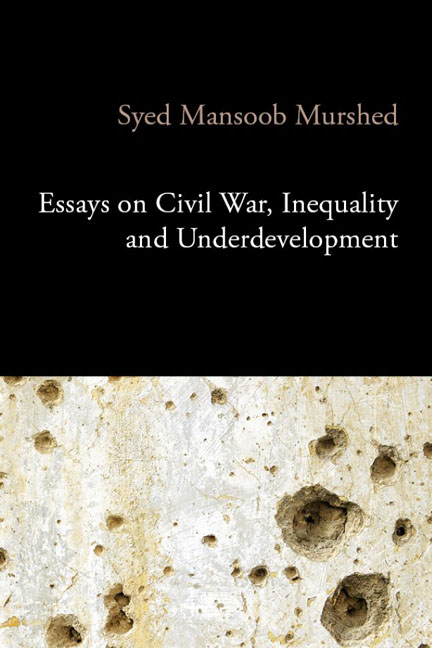Book contents
- Frontmatter
- Contents
- Preface
- Tables and figures
- 1 Conflict, civil war and underdevelopment
- 2 Revisiting the greed and grievance explanations for violent conflict
- 3 Greed, grievance and globalization
- 4 Economic dimensions of the liberal peace and its implications for conflict in developing countries
- 5 Enforcing peace agreements through commitment technologies
- 6 The conflict–growth nexus and the poverty of nations
- 7 Conflict and fiscal capacity
- 8 Does civil war hamper financial development?
- 9 The clash of civilizations and the interaction between fear and hatred
- 10 Transnational terrorism as a spillover of domestic disputes in other countries
- 11 Quantitative restrictions on the flow of narcotics: supply and demand restraints in a North–South macro-model
- 12 Spatial-horizontal inequality and the Maoist conflict in Nepal
- 13 Socioeconomic determinants of everyday violence in Indonesia: an empirical investigation of Javanese districts, 1994–2003
- 14 Not loving thy neighbour as thyself: trade, democracy and military expenditure explanations underlying India–Pakistan rivalry
- Acknowledgements
- References
- Index
9 - The clash of civilizations and the interaction between fear and hatred
Published online by Cambridge University Press: 09 January 2024
- Frontmatter
- Contents
- Preface
- Tables and figures
- 1 Conflict, civil war and underdevelopment
- 2 Revisiting the greed and grievance explanations for violent conflict
- 3 Greed, grievance and globalization
- 4 Economic dimensions of the liberal peace and its implications for conflict in developing countries
- 5 Enforcing peace agreements through commitment technologies
- 6 The conflict–growth nexus and the poverty of nations
- 7 Conflict and fiscal capacity
- 8 Does civil war hamper financial development?
- 9 The clash of civilizations and the interaction between fear and hatred
- 10 Transnational terrorism as a spillover of domestic disputes in other countries
- 11 Quantitative restrictions on the flow of narcotics: supply and demand restraints in a North–South macro-model
- 12 Spatial-horizontal inequality and the Maoist conflict in Nepal
- 13 Socioeconomic determinants of everyday violence in Indonesia: an empirical investigation of Javanese districts, 1994–2003
- 14 Not loving thy neighbour as thyself: trade, democracy and military expenditure explanations underlying India–Pakistan rivalry
- Acknowledgements
- References
- Index
Summary
Introduction
This chapter presents a model of conflict between a West European state or society and domestic dissident immigrant minority groups, such as Muslims. Most of the literature focuses on either the radicalization of young Muslims in Europe or on their links with international terrorism, but rarely models the clash or interaction between the state or majority community and the ‘enemy within’. Identity plays a major part in this, and Akerlof and Kranton (2000) suggest that individuals obtain utility from their identity and by making themselves, as well as others in their group, behave in conformity with group norms. But it also has to be borne in mind that individuals often have multiple identities, as emphasized by Sen (2008). It is possible, therefore, to be both Muslim and European and to believe in most values that characterize Western humanism. The dislike of resident Muslim minority groups amongst the majority (Islamophobia) is not only founded upon real dangers of violent potential from certain Muslim elements, but is also a product of adverse propaganda about them, some of which may be only partially true. In what follows I define this as fear. Segments of the minority group (fundamentalists) may feel hatred for the West. This hate results from present-day socio-economic injustices against them in the European countries, historical injustices and contemporary foreign policy actions. Dislike of the West manifests itself in a spectrum of activities ranging from innocuous actions, such as the expression of disagreement, to making statements of difference via the adoption of dress codes (the wearing of the hijab or head scarf, for example) which to some Westerners is an offensive rejection of Western values, to acts of vandalism, such as the riots (looting, car burning) in the suburbs of Paris, and finally to the more violent terrorist actions such as the Madrid train bombings of March 2004, or the London bombings of July 2005. The interaction between this fear of Muslims and Muslim hatred for the West might sometimes produce only a disagreeable atmosphere, but at other times, can result in fatal conflict. What transforms this latent danger into violence and terrorism?
- Type
- Chapter
- Information
- Essays on Civil War, Inequality and Underdevelopment , pp. 151 - 164Publisher: Agenda PublishingPrint publication year: 2021



